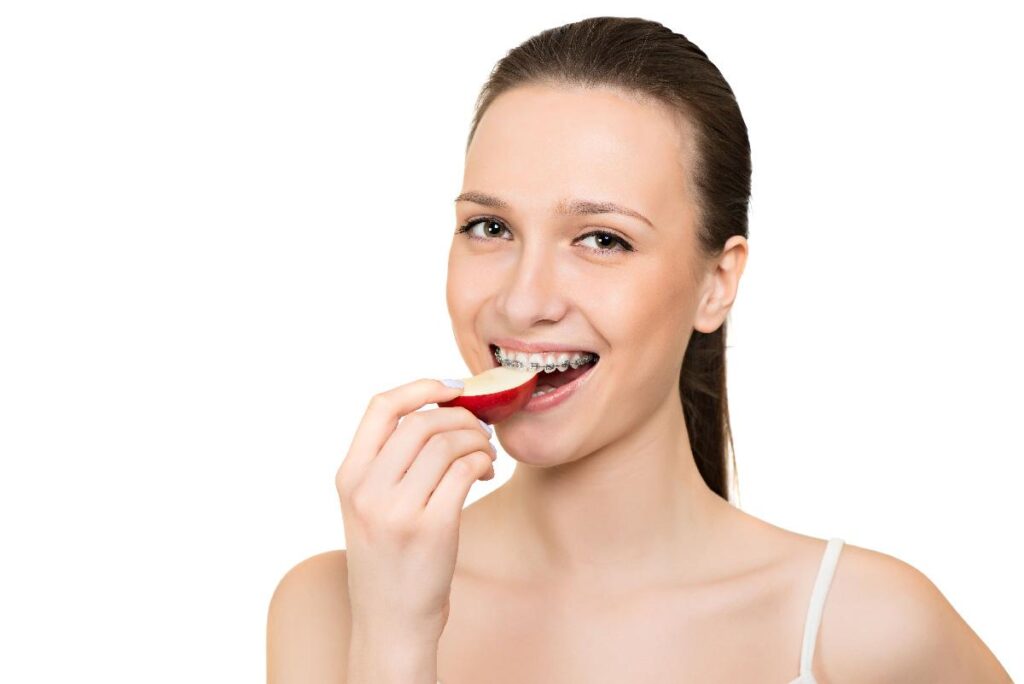Clear aligners have become increasingly popular in recent years as a discreet and comfortable way to straighten teeth. Unlike traditional metal braces, clear aligners are virtually invisible and can be removed for eating and oral hygiene.
However, because they are made of a thin, clear plastic material, there are certain restrictions on what you can eat while wearing clear aligners. In this guide, we’ll explore the food restrictions and provide tips on what you can eat to keep them in great condition.
The Basics

Source: diamondbraces.com
Clear aligners are an orthodontic treatment that uses a series of clear, plastic aligners to gradually move teeth into their correct position. Each set is custom-made to fit the patient’s teeth, and each aligner set is worn for a specific amount of time before being replaced by the next set in the series. The treatment time varies depending on the complexity of the case but typically lasts from several months to over a year.
One of the benefits is their removable nature, which means patients can take them out when eating, brushing their teeth, or flossing. This makes it easier to maintain good oral hygiene throughout the treatment process. However, it’s important to note that they must be worn for at least 22 hours a day to be effective, so it’s crucial that patients remember to put them back in after eating or cleaning their teeth.
They are a great option for patients who want a discreet and comfortable orthodontic treatment. They are virtually invisible, making them an attractive alternative to traditional metal braces, which can be conspicuous and uncomfortable. Additionally, they are less likely to cause irritation or discomfort to the mouth and gums, making them a good choice for patients with sensitive mouths.
However, it’s important to follow the guidelines provided by the orthodontist when wearing them, including food restrictions. Certain foods can damage them or hinder their effectiveness, so it’s important to be mindful of what you eat while undergoing treatment. By following these guidelines and being consistent with wearing them, you can achieve the straight, healthy smile you’ve always wanted.
Foods to Avoid
There are certain foods that you should avoid while wearing clear aligners. These foods can damage them or cause them to become discolored. Here are some examples of foods to avoid:
Sticky Foods
They should be avoided while wearing clear aligners. Foods such as caramels, taffy, and chewing gum can stick to them and are difficult to remove. This can not only damage the aligners but also increase the risk of tooth decay, as sticky foods tend to linger in the mouth for longer periods of time.
If you do consume sticky foods, it’s important to remove them first. This can help prevent them from becoming damaged or discolored. It’s also crucial to thoroughly clean your teeth and aligners after consuming these foods to prevent any residual stickiness from causing problems.
Alternatively, it’s best to opt for other snacks that won’t stick to your aligners, such as fruit, cheese, or crackers. These snacks are easy to chew and won’t damage the aligners or cause any oral health issues.

Source: hovedentalclinic.co.uk
Hard Foods
Hard foods are another category of foods that should be avoided while wearing them. Foods such as nuts, hard candies, and ice can put undue pressure on the aligners, causing them to crack or break. Additionally, biting down on hard foods can damage the teeth, particularly if they are already shifting due to orthodontic treatment.
To avoid damaging the aligners and teeth, it’s important to avoid biting down on hard foods while wearing them. Instead, opt for softer alternatives, such as cooked vegetables, soft fruits, or baked goods. These foods are easier to chew and won’t cause any undue pressure on the aligners or teeth.
Crunchy Foods
Crunchy foods are a common source of concern for patients wearing clear aligners. Foods like carrots, apples, and popcorn can be hard and crunchy, which can put pressure on the aligners and even cause them to crack or break. Additionally, small pieces of these foods can become lodged in them, making them difficult to clean.
However, this doesn’t mean you have to give up crunchy foods altogether while undergoing clear aligner treatment. There are a few tips to help you enjoy these foods while keeping them in good condition.
It’s important to cut crunchy foods into small pieces before eating them. This not only reduces the pressure but also makes it easier to clean out any debris that may become stuck. Using a knife to slice fruits and vegetables into small pieces is a great way to enjoy them without damaging them.
Sugary Drinks

Source: invisalign.com.au
Sugary drinks such as soda, energy drinks, and fruit juices should be consumed in moderation while wearing clear aligners. These drinks can cause tooth decay and damage the aligners, as the sugar can get stuck in them and increase the risk of bacterial growth. It’s best to opt for water, unsweetened tea, or other sugar-free beverages while wearing them. If you do consume sugary drinks, it’s important to rinse your mouth with water and brush your teeth and thoroughly afterward to prevent any damage or decay.
Tips for Eating with Clear Aligners
While there are certain foods that you should avoid with them, there are still plenty of foods that you can enjoy. Here are some tips for eating with clear aligners:
- Remove them before eating: This will help prevent damage to your aligners and make it easier to clean your teeth after eating.
- Brush and floss after eating: It’s important to keep your teeth and aligners clean to prevent bacteria from building up.
- Cut your food into small pieces: This will make it easier to eat and help prevent damage.
- Choose soft, easy-to-chew foods: Foods like pasta, rice, and cooked vegetables are great options.
- Drink plenty of water: Water is the best drink for your teeth and can help wash away food particles and bacteria.
Smiling Your Way to Success: Navigating Food Restrictions with Clear Aligners
In conclusion, having clear aligners doesn’t mean you have to compromise your favorite foods or your oral health. By being mindful of what you eat and following a few simple tips, you can ensure that your clear aligners stay in great condition and your teeth continue to move toward their desired position. Remember to remove your aligners before eating, brush and floss regularly, and choose soft, easy-to-chew foods.
By doing so, you’ll be well on your way to achieving the smile you’ve always wanted. Keep in mind that if you have any questions or concerns about your clear aligners and diet, your orthodontist is always available to help you out. With them, you’ll be smiling your way to success in no time.
